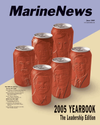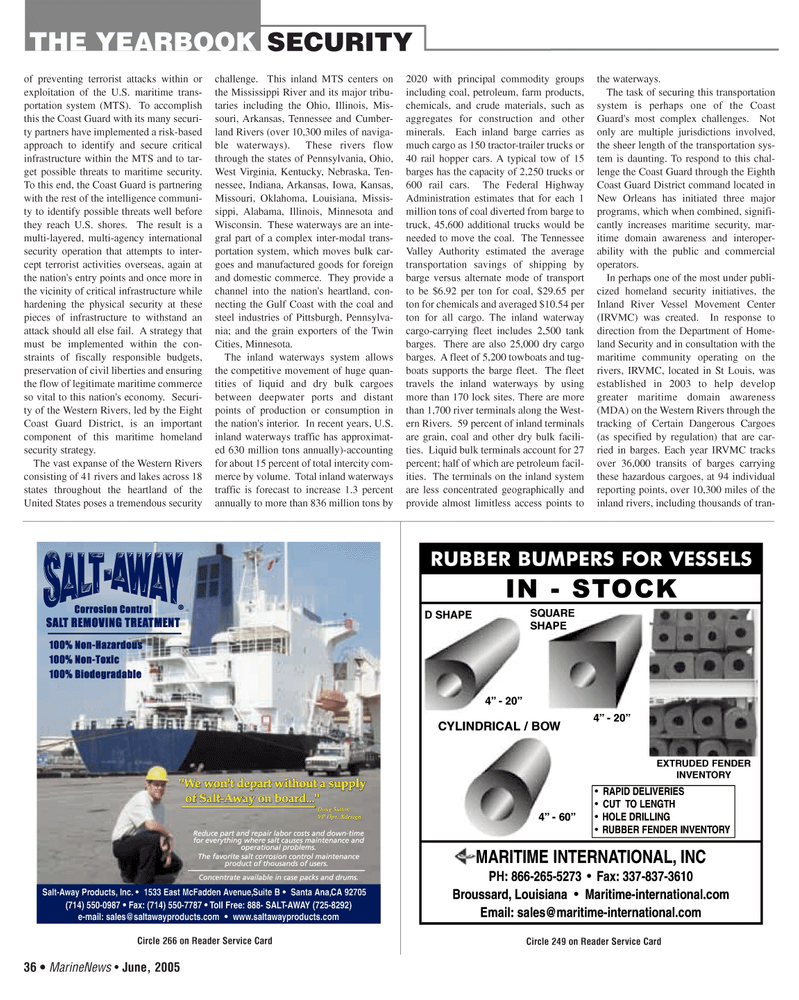
Page 36: of Marine News Magazine (June 2005)
Read this page in Pdf, Flash or Html5 edition of June 2005 Marine News Magazine
of preventing terrorist attacks within or exploitation of the U.S. maritime trans- portation system (MTS). To accomplish this the Coast Guard with its many securi- ty partners have implemented a risk-based approach to identify and secure critical infrastructure within the MTS and to tar- get possible threats to maritime security.
To this end, the Coast Guard is partnering with the rest of the intelligence communi- ty to identify possible threats well before they reach U.S. shores. The result is a multi-layered, multi-agency international security operation that attempts to inter- cept terrorist activities overseas, again at the nation's entry points and once more in the vicinity of critical infrastructure while hardening the physical security at these pieces of infrastructure to withstand an attack should all else fail. A strategy that must be implemented within the con- straints of fiscally responsible budgets, preservation of civil liberties and ensuring the flow of legitimate maritime commerce so vital to this nation's economy. Securi- ty of the Western Rivers, led by the Eight
Coast Guard District, is an important component of this maritime homeland security strategy.
The vast expanse of the Western Rivers consisting of 41 rivers and lakes across 18 states throughout the heartland of the
United States poses a tremendous security challenge. This inland MTS centers on the Mississippi River and its major tribu- taries including the Ohio, Illinois, Mis- souri, Arkansas, Tennessee and Cumber- land Rivers (over 10,300 miles of naviga- ble waterways). These rivers flow through the states of Pennsylvania, Ohio,
West Virginia, Kentucky, Nebraska, Ten- nessee, Indiana, Arkansas, Iowa, Kansas,
Missouri, Oklahoma, Louisiana, Missis- sippi, Alabama, Illinois, Minnesota and
Wisconsin. These waterways are an inte- gral part of a complex inter-modal trans- portation system, which moves bulk car- goes and manufactured goods for foreign and domestic commerce. They provide a channel into the nation's heartland, con- necting the Gulf Coast with the coal and steel industries of Pittsburgh, Pennsylva- nia; and the grain exporters of the Twin
Cities, Minnesota.
The inland waterways system allows the competitive movement of huge quan- tities of liquid and dry bulk cargoes between deepwater ports and distant points of production or consumption in the nation's interior. In recent years, U.S. inland waterways traffic has approximat- ed 630 million tons annually)-accounting for about 15 percent of total intercity com- merce by volume. Total inland waterways traffic is forecast to increase 1.3 percent annually to more than 836 million tons by 2020 with principal commodity groups including coal, petroleum, farm products, chemicals, and crude materials, such as aggregates for construction and other minerals. Each inland barge carries as much cargo as 150 tractor-trailer trucks or 40 rail hopper cars. A typical tow of 15 barges has the capacity of 2,250 trucks or 600 rail cars. The Federal Highway
Administration estimates that for each 1 million tons of coal diverted from barge to truck, 45,600 additional trucks would be needed to move the coal. The Tennessee
Valley Authority estimated the average transportation savings of shipping by barge versus alternate mode of transport to be $6.92 per ton for coal, $29.65 per ton for chemicals and averaged $10.54 per ton for all cargo. The inland waterway cargo-carrying fleet includes 2,500 tank barges. There are also 25,000 dry cargo barges. A fleet of 5,200 towboats and tug- boats supports the barge fleet. The fleet travels the inland waterways by using more than 170 lock sites. There are more than 1,700 river terminals along the West- ern Rivers. 59 percent of inland terminals are grain, coal and other dry bulk facili- ties. Liquid bulk terminals account for 27 percent; half of which are petroleum facil- ities. The terminals on the inland system are less concentrated geographically and provide almost limitless access points to the waterways.
The task of securing this transportation system is perhaps one of the Coast
Guard's most complex challenges. Not only are multiple jurisdictions involved, the sheer length of the transportation sys- tem is daunting. To respond to this chal- lenge the Coast Guard through the Eighth
Coast Guard District command located in
New Orleans has initiated three major programs, which when combined, signifi- cantly increases maritime security, mar- itime domain awareness and interoper- ability with the public and commercial operators.
In perhaps one of the most under publi- cized homeland security initiatives, the
Inland River Vessel Movement Center (IRVMC) was created. In response to direction from the Department of Home- land Security and in consultation with the maritime community operating on the rivers, IRVMC, located in St Louis, was established in 2003 to help develop greater maritime domain awareness (MDA) on the Western Rivers through the tracking of Certain Dangerous Cargoes (as specified by regulation) that are car- ried in barges. Each year IRVMC tracks over 36,000 transits of barges carrying these hazardous cargoes, at 94 individual reporting points, over 10,300 miles of the inland rivers, including thousands of tran- 36 • MarineNews • June, 2005
Salt-Away Products, Inc. • 1533 East McFadden Avenue, Suite B • Santa Ana, CA 92705 (714) 550-0987 • Fax: (714) 550-7787 • Toll Free: 888- SALT-AWAY (725-8292) e-mail: [email protected] • www.saltawayproducts.com
RUBBER BUMPERS FOR VESSELS
IN - STOCK
D SHAPE
CYLINDRICAL / BOW
EXTRUDED FENDER
INVENTORY
SQUARE
SHAPE 4” - 20” 4” - 20” 4” - 60”
MARITIME INTERNATIONAL, INC
PH: 866-265-5273 • Fax: 337-837-3610
Broussard, Louisiana • Maritime-international.com
Email: [email protected] • RAPID DELIVERIES • CUT TO LENGTH • HOLE DRILLING • RUBBER FENDER INVENTORY
Circle 266 on Reader Service Card Circle 249 on Reader Service Card
SECURITYTHE YEARBOOK
JUNEMN2005 5(33-40).qxd 5/26/2005 10:47 AM Page 36

 35
35

 37
37
